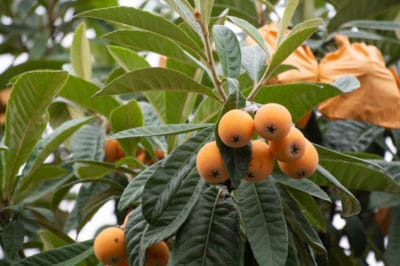A Warm South Texas Welcome
Loquat trees handle winter cold in USDA plant hardiness ones 8 through 10, with a minimum low temperature of 10°F (-12.2°C). And — because loquats flower and set fruit between October and February – south Texas’ balmy winters suit them perfectly. Grow them anywhere along the Gulf Coast and as far north as San Antonio for fruit.
Further north, loquats face fruit-killing winter temps below 27°F (-2.8°C). They’ll still make handsome evergreen shade trees with delicate, sweetly fragrant flowers — and for most Texas gardeners, that’s enough.
Expert gardener’s tips:
- If you’re along the southern edge of zone 8, plant the loquat on a structure’s southern or southeastern side. The added cold protection increases your chance of a fruit harvest.
- If your summer temps regularly top 100°F (37.8°C), position your tree to get afternoon shade. During its first summer, also protect it from late morning sun with a shade cloth.
Loquats and Texas Soil
Given good drainage, a loquat is at home in the limestone-heavy soils of south, central or north Texas and the acidic soils of the eastern counties. Salty soils, however, burn its leaf tips when summer is very hot and dry. Minimize the problem with proper care.
Fighting Tip Burn
The best way to prevent tip burn is to avoid chemically based nitrogen fertilizer. Compost and 0-10-10 fish emulsion are safe organic options.
Right after planting, spread a 1-inch layer of compost over the soil around the root ball. It conserves soil moisture and supply nutrients while breaking down.
After two or three months, start feeding the tree with fish emulsion:
- Dilute 2 tablespoons (30 ml) of the emulsion in 1 gallon (3.78 liters) of water. This makes enough to cover 25 square feet of soil.
- Spray the solution on the leaves.
- Pour the remaining solution around the base of the tree and water it in.
- Repeat every three weeks through the growing season.
Beginning in the second year, apply the fish emulsion monthly during the growing season.
Best Loquat Cultivars for Texas
Texas summers can wreak havoc on loquat fruit, so plant an early ripening cultivar. ‘Early Red’s’ clusters of sweet, juicy fruit ripen in January and February. To extend your harvest into April, pair it with ‘Big Jim,’ a choice notable for large, exceptionally sweet fruit.
